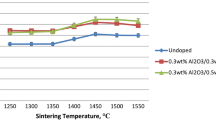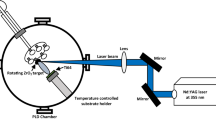Abstract
Bulk yttria-stabilized zirconia is a well-studied material with various applications, in particular for biomedical devices. Interestingly, it is now possible to obtain thin stand-alone sheets (40 µm thick) of this material. We present a preliminary study dealing with the aging of these foils to determine whether they would be suitable for implantable neurostimulator housing. Accelerated hydrothermal aging experiments were performed at 134 °C and 2 bar. Various analyses of the material were carried out, especially by atomic force microscopy, X-ray diffraction, scanning electron microscopy, transmission electron microscopy, and UV–visible-near-infrared spectroscopy. The results show that the foils maintain their integrity during simulated long-term in vivo experiments, which indicates that they are not prone to fast degradation. The observed monoclinic transformation initiates from the surface and propagates into the bulk, leading to two distinct observable parts within the sheet. The aged and the non-aged parts are separated by a limit almost linear and parallel to the surface. We also show that the micro-strains are not altered significantly after 5 h accelerated aging, and that the optical properties are not modified despite structural modifications. Although further work is needed, we have shown that foils of yttria-stabilized zirconia resist accelerated aging and are thus a promising material for the fabrication of ultrathin implantable devices.













Similar content being viewed by others
References
Benabid A-L, Pollak P, Louveau A et al (1987) Combined (thalamotomy and stimulation) stereotactic surgery of the VIM thalamic nucleus for bilateral Parkinson disease. Appl Neurophysiol 50:344–346
Chan DTM, Zhu XL, Yeung JHM et al (2009) Complications of deep brain stimulation: a collective review. Asian J Surg 32:258–263
Lozano AM, Dostrovsky J, Chen R, Ashby P (2002) Deep brain stimulation for Parkinson’ s disease: disrupting the disruption. Lancet Neurol 1:225–231
Denry I, Kelly JR (2008) State of the art of zirconia for dental applications. Dent Mater 24:299–307
Afzal A (2014) Implantable zirconia bioceramics for bone repair and replacement: a chronological review. Mater Express 4:1–12
Ratner BD, Hoffman AS, Schoen FJ, Lemons JE (2004) Biomaterials science. Academic Press, Boston
Leyens C, Peters M (2003) Titanium and titanium alloys: fundamentals and applications. Wiley-VCH, New York
Zitter H, Plenk H Jr (1987) The electrochemical behavior of metallic implant materials as an indicator of their biocompatibility. J Biomed Mater Res 21:881–896
Bogdanski D, Köller M, Müller D et al (2002) Easy assessment of the biocompatibility of Ni-Ti alloys by in vitro cell culture experiments on a functionally graded Ni-NiTi-Ti material. Biomaterials 23:4549–4555
Sato T, Ohtaki S, Shimada M (1985) Transformation of yttria partially stabilized zirconia by low temperature annealing in air. J Mater Sci 20:1466–1470. doi:10.1007/BF01026344
Piconi C, Maccauro G (1999) Zirconia as a ceramic biomaterial. Biomaterials 20:1–25
Guo X (2004) Property degradation of tetragonal zirconia induced by low-temperature defect reaction with water molecules. Chem Mater 109:3988–3994
Deville S, Chevalier J, Gremillard L (2006) Influence of surface finish and residual stresses on the ageing sensitivity of biomedical grade zirconia. Biomaterials 27:2186–2192
Burger W, Richter HG, Piconi C et al (1997) New Y-TZP powders for medical grade zirconia. J Mater Sci Mater Med 8:113–118
Kobayashi K, Kuwajima H, Masaki T (1981) Phase change and mechanical properties of ZrO2-Y2O3 solid electrolytes after ageing. Solid State Ionics 3–4:489–493
Chevalier J, Gremillard L, Deville S (2007) Low-temperature degradation of zirconia and implications for biomedical implants. Annu Rev Mater Res 37:1–32
Clarke IC, Manaka M, Green DD et al (2003) Current status of zirconia used in total hip implants. J Bone Jt Surg 85:73–84
Reyes-Rojas A, Torres-Moye E, Solís-Canto O et al (2012) X-ray diffraction and atomic force microscopy study in aged zirconia-toughened alumina composite with dispersion of m-ZrO2 nanoparticles. Int J Refract Met Hard Mater 35:270–278
Chintapalli RK, Mestra Rodriguez A, Garcia Marro F, Anglada M (2014) Effect of sandblasting and residual stress on strength of zirconia for restorative dentistry applications. J Mech Behav Biomed Mater 29:126–137
Deville S, Chevalier J, Gremillard L (2005) Atomic force microscopy study of the tetragonal to monoclinic transformation behavior of silica doped yttria-stabilized zirconia. J Mater Sci 40:3821–3823. doi:10.1007/s10853-005-2550-2
Chevalier J, Cales B, Drouin JM (1999) Low-temperature aging of Y-TZP ceramics. J Am Ceram Soc 82:2150–2154
Chevalier J, Gremillard L (2009) Ceramics for medical applications: a picture for the next 20 years. J Eur Ceram Soc 29:1245–1255
Wang G, Liu X, Gao J, Ding C (2009) In vitro bioactivity and phase stability of plasma-sprayed nanostructured 3Y-TZP coatings. Acta Biomater 5:2270–2278
Wang G, Liu X, Ding C (2008) Phase composition and in vitro bioactivity of plasma sprayed calcia stabilized zirconia coatings. Surf Coat Technol 202:5824–5831
Wang G, Meng F, Ding C et al (2010) Microstructure, bioactivity and osteoblast behavior of monoclinic zirconia coating with nanostructured surface. Acta Biomater 6:990–1000
Romero Pareja R, López Ibáñez R, Martín F et al (2006) Corrosion behaviour of zirconia barrier coatings on galvanized steel. Surf Coat Technol 200:6606–6610
Wright PK, Evans AG (1999) Mechanisms governing the performance of thermal barrier coatings. Curr Opin Solid State Mater Sci 4:255–265
Paek JY, Chang I, Park JH et al (2014) A study on properties of yttrium-stabilized zirconia thin films fabricated by different deposition techniques. Renew Energy 65:202–206
Chan EK, Sorg B, Protsenko D et al (1996) Effect of compression on soft tissue optical properties. IEEE J Sel Top Quantum Electron 2:943–950
ISO13356 (2013) Implants for surgery—ceramic materials based on yttria-stabilized tetragonal zirconia (Y-TZP)
Chevalier J, Deville S, Münch E et al (2004) Critical effect of cubic phase on aging in 3 mol% yttria-stabilized zirconia ceramics for hip replacement prosthesis. Biomaterials 25:5539–5545
Deville S, Chevalier J, Fantozzi G et al (2004) Atomic force microscopy study of the surface degradation mechanisms of zirconia based ceramics. Ceram Eng Sci Proc 25:289–294
Garvie RC, Nicholson PS (1972) Phase analysis in zirconia systems. J Am Ceram Soc 55:303–305
Tsubakino H, Kuroda Y, Niibe M (1999) Surface relief associated with isothermal martensite in zirconia-3-mol%-yttria ceramics observed by atomic force microscopy. J Am Ceram Soc 82:2921–2923
Muñoz-Tabares JA, Jiménez-Piqué E, Anglada M (2011) Subsurface evaluation of hydrothermal degradation of zirconia. Acta Mater 59:473–484
Keuper M, Eder K, Berthold C, Nickel KG (2013) Direct evidence for continuous linear kinetics in the low-temperature degradation of Y-TZP. Acta Biomater 9:4826–4835
Deville S, Gremillard L, Chevalier J, Fantozzi G (2005) A critical comparison of methods for the determination of the aging sensitivity in biomedical grade yttria-stabilized zirconia. J Biomed Mater Res B 72:239–245
Gremillard L, Chevalier J, Epicier T et al (2004) Modeling the aging kinetics of zirconia ceramics. J Eur Ceram Soc 24:3483–3489
Chevalier J, Gremillard L, Virkar AV, Clarke DR (2009) The tetragonal-monoclinic transformation in zirconia: lessons learned and future trends. J Am Ceram Soc 92:1901–1920
Kim YS, Jung CH, Park JY (1994) Low temperature degradation of yttria-stabilized tetragonal zirconia polycrystals under aqueous solutions. J Nucl Mater 209:326–331
Wulfman C, Djaker N, Sadoun M, Lamy de la Chapelle M (2014) 3Y-TZP in-depth phase transformation by raman spectroscopy: a comparison of three methods. J Am Ceram Soc 97:2233–2240
Gremillard L, Grandjean S, Chevalier J (2013) A new method to measure monoclinic depth profile in zirconia-based ceramics drom X-ray diffraction data. Int J Mater Res 101:88–94
Acknowledgements
The authors would like to thank H. Fournier and G. Lorin for their technical help.
Author information
Authors and Affiliations
Corresponding author
Electronic supplementary material
Below is the link to the electronic supplementary material.
Rights and permissions
About this article
Cite this article
Le Coadou, C., Karst, N., Emieux, F. et al. Assessment of ultrathin yttria-stabilized zirconia foils for biomedical applications. J Mater Sci 50, 6197–6207 (2015). https://doi.org/10.1007/s10853-015-9178-7
Received:
Accepted:
Published:
Issue Date:
DOI: https://doi.org/10.1007/s10853-015-9178-7




